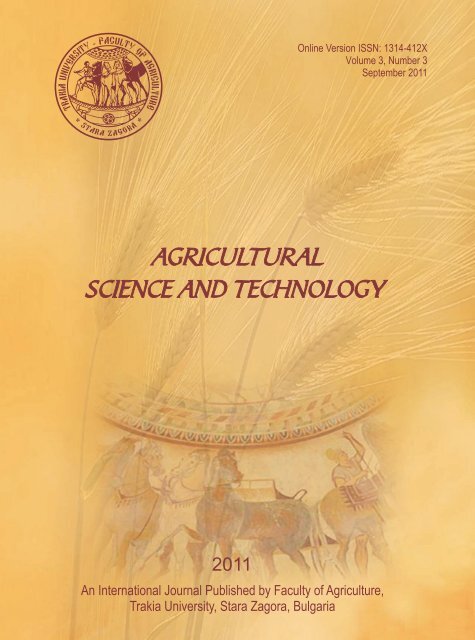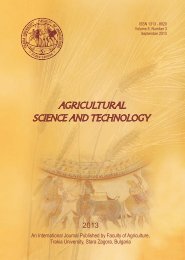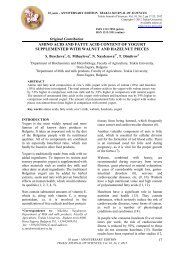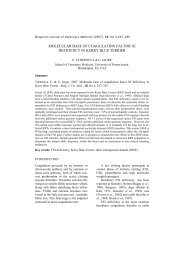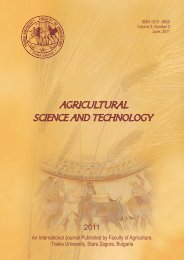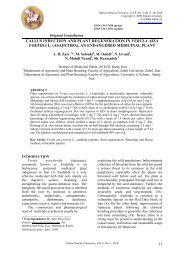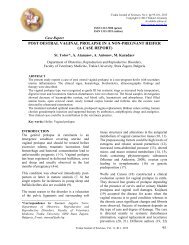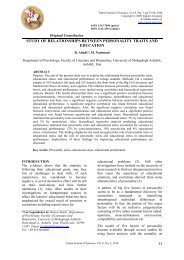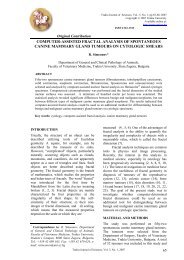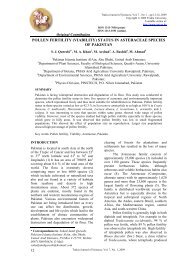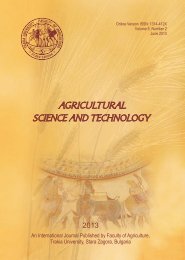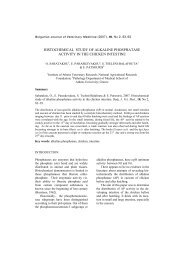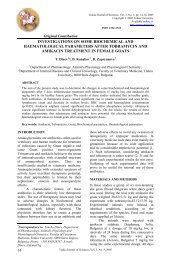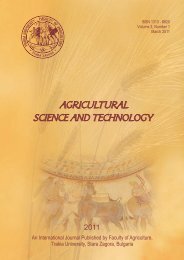GB_1 -Selection of oil-bearing rose in Bulgaria
GB_1 -Selection of oil-bearing rose in Bulgaria
GB_1 -Selection of oil-bearing rose in Bulgaria
You also want an ePaper? Increase the reach of your titles
YUMPU automatically turns print PDFs into web optimized ePapers that Google loves.
2011<br />
Onl<strong>in</strong>e Version ISSN: 1314-412X<br />
Volume 3, Number 3<br />
September 2011
Georgi Zhelyazkov (<strong>Bulgaria</strong>)<br />
Scope and policy <strong>of</strong> the journal<br />
Agricultural Science and Technology /AST/<br />
– an International Scientific Journal <strong>of</strong><br />
Agricultural and Technology Sciences is<br />
published <strong>in</strong> English <strong>in</strong> one volume <strong>of</strong> 4<br />
issues per year, as a pr<strong>in</strong>ted journal and <strong>in</strong><br />
electronic form. The policy <strong>of</strong> the journal is<br />
to publish orig<strong>in</strong>al papers, reviews and<br />
short communications cover<strong>in</strong>g the<br />
aspects <strong>of</strong> agriculture related with life<br />
sciences and modern technologies. It will<br />
<strong>of</strong>fer opportunities to address the global<br />
needs relat<strong>in</strong>g to food and environment,<br />
health, exploit the technology to provide<br />
<strong>in</strong>novative products and susta<strong>in</strong>able<br />
development. Papers will be considered <strong>in</strong><br />
aspects <strong>of</strong> both fundamental and applied<br />
science <strong>in</strong> the areas <strong>of</strong> Genetics and<br />
Breed<strong>in</strong>g, Nutrition and Physiology,<br />
Production Systems, Agriculture and<br />
Environment and Product Quality and<br />
Safety. Other categories closely related to<br />
the above topics could be considered by<br />
the editors. The detailed <strong>in</strong>formation <strong>of</strong> the<br />
journal is available at the website.<br />
Proceed<strong>in</strong>gs <strong>of</strong> scientific meet<strong>in</strong>gs and<br />
conference reports will be considered for<br />
special issues.<br />
Submission <strong>of</strong> Manuscripts<br />
All manuscript written <strong>in</strong> English should be<br />
submitted as MS-Word file attachments via<br />
e-mail to ascitech@uni-sz.bg. Manuscripts<br />
must be prepared strictly <strong>in</strong> accordance<br />
with the detailed <strong>in</strong>structions for authors at<br />
the website<br />
http://www.uni-sz.bg/ascitech/<strong>in</strong>dex.html<br />
and the <strong>in</strong>structions on the last page <strong>of</strong> the<br />
journal. For each manuscript the<br />
signatures <strong>of</strong> all authors are needed<br />
confirm<strong>in</strong>g their consent to publish it and to<br />
nom<strong>in</strong>ate on author for correspondence.<br />
They have to be presented by a<br />
submission letter signed by all authors.<br />
The form <strong>of</strong> the submission letter is<br />
available upon from request from the<br />
Technical Assistance or could be<br />
downloaded from the website <strong>of</strong> the<br />
journal. All manuscripts are subject to<br />
editorial review and the editors reserve the<br />
right to improve style and return the paper<br />
for rewrit<strong>in</strong>g to the authors, if necessary.<br />
The editorial board reserves rights to reject<br />
manuscripts based on priorities and space<br />
availability <strong>in</strong> the journal.<br />
Subscriptions<br />
Agricultural Science and Technology is<br />
published four times a year. The<br />
subscription price for <strong>in</strong>stitutions is 80 €<br />
and for personal subscription 30 € which<br />
<strong>in</strong>clude electronic access and delivery.<br />
Subscription run for full calendar year.<br />
Orders, which must be accompanied by<br />
payment may be sent direct to the<br />
publisher:<br />
Trakia University<br />
Faculty <strong>of</strong> Agriculture, Bank account:<br />
UniCredit Bulbank,<br />
S<strong>of</strong>ia BIC: UNCRBGSF<br />
IBAN: BG29UNCR76303100117681<br />
With UniCredit Bulbank Stara Zagora<br />
Internet Access<br />
This journal is <strong>in</strong>cluded <strong>in</strong> the Trakia<br />
University Journals onl<strong>in</strong>e Service which<br />
can be found at www.uni-sz.bg.<br />
Copyright<br />
All rights reserved. No part <strong>of</strong> this<br />
publications may be translated <strong>in</strong>to other<br />
languages, reproduced or utilized <strong>in</strong> any<br />
form or by any means, electronic or<br />
mechanical, <strong>in</strong>clud<strong>in</strong>g photocopy<strong>in</strong>g or any<br />
<strong>in</strong>formation storage and retrieval system<br />
without permission <strong>in</strong> writ<strong>in</strong>g from the<br />
publisher.<br />
Address <strong>of</strong> Editorial <strong>of</strong>fice:<br />
Agricultural Science and Technology<br />
Faculty <strong>of</strong> Agriculture, Trakia University<br />
Student's campus, 6000 Stara Zagora<br />
<strong>Bulgaria</strong><br />
Telephone.: +359 42 699330<br />
+359 42 699446<br />
http://www.uni-sz.bg/ascitech/<strong>in</strong>dex.html<br />
Technical Assistance:<br />
Nely Tzvetanova<br />
Telephone.: +359 42 699446<br />
E-mail: ascitech@uni-sz.bg
Onl<strong>in</strong>e Version ISSN: 1314-412X<br />
2011<br />
Volume 3, Number 3<br />
September 2011
AGRICULTURAL SCIENCE AND TECHNOLOGY, VOL. 3, No 3, pp 189 - 192, 2011<br />
Genetics and Breed<strong>in</strong>g<br />
<strong>Selection</strong> <strong>of</strong> <strong>oil</strong>-<strong>bear<strong>in</strong>g</strong> <strong>rose</strong> <strong>in</strong> <strong>Bulgaria</strong> – tendencies and perspective<br />
N. Kovatcheva*<br />
Institute <strong>of</strong> Roses, Essential and Medical Cultures, 49 Osvobozhdenie, 6100 Kazanlak, <strong>Bulgaria</strong><br />
Abstract. The <strong>oil</strong>-<strong>bear<strong>in</strong>g</strong> <strong>rose</strong> (Rosa damascena Mill.f.trig<strong>in</strong>tipetala Dieck) is <strong>of</strong> priority economic importance to <strong>Bulgaria</strong>, whose products are entirely export<br />
oriented. The ma<strong>in</strong> limit<strong>in</strong>g factor for its development are meteorology conditions throughout the grow<strong>in</strong>g season. These abiotic factors have exerted a grow<strong>in</strong>g<br />
<strong>in</strong>fluence <strong>in</strong> recent years, result<strong>in</strong>g <strong>in</strong> reduced production traits. The direction <strong>of</strong> the selection <strong>of</strong> the <strong>oil</strong>-<strong>bear<strong>in</strong>g</strong> <strong>rose</strong> is associated with <strong>of</strong>fer<strong>in</strong>g high-variety,<br />
selection <strong>of</strong> promis<strong>in</strong>g branches resistant to abiotic stress. Given the rich gene fund <strong>of</strong> the assembly orig<strong>in</strong>, variety, hybrids at the Institute <strong>of</strong> Roses, Essential<br />
and Medical Cultures, <strong>Bulgaria</strong>, a lection program has been developed that reflects the ma<strong>in</strong> stages <strong>of</strong> research.<br />
Keywords: <strong>oil</strong>-<strong>bear<strong>in</strong>g</strong> <strong>rose</strong>s, selection, gene fund<br />
Introduction Preservation <strong>of</strong> genetic resources <strong>of</strong> <strong>oil</strong>-<strong>bear<strong>in</strong>g</strong><br />
Kazanlak <strong>rose</strong> (Rosa damascena Mill.f.trig<strong>in</strong>tipetala Dieck) has<br />
<strong>rose</strong>s<br />
been the subject <strong>of</strong> research for more than 90 years, the beg<strong>in</strong>n<strong>in</strong>g <strong>of</strong><br />
this activity was placed <strong>in</strong> the experimental field <strong>in</strong> Kazanlak <strong>in</strong> 1922.<br />
Today the <strong>oil</strong>-<strong>bear<strong>in</strong>g</strong> <strong>rose</strong> is a major essential <strong>oil</strong> plant for our<br />
country. It is grown <strong>in</strong> the traditional for this production area <strong>of</strong> the<br />
Rose Valley. At present <strong>in</strong> our country the population <strong>of</strong> the Kazanlak<br />
<strong>rose</strong> has <strong>in</strong>creased and it occupies almost 100% <strong>of</strong> the areas <strong>in</strong> the<br />
country. The population is an amalgamation <strong>of</strong> selected promis<strong>in</strong>g<br />
orig<strong>in</strong>. It will ma<strong>in</strong>ta<strong>in</strong> a certa<strong>in</strong> standard <strong>of</strong> <strong>Bulgaria</strong>n <strong>rose</strong> <strong>oil</strong> and<br />
ensure its excellent quality. From the selected <strong>Bulgaria</strong>n varieties<br />
there are also some limited areas and basically ma<strong>in</strong>ta<strong>in</strong>ed at the<br />
Institute <strong>of</strong> Rose. Each <strong>of</strong> them is characterized by productive<br />
<strong>in</strong>dicators and quality <strong>of</strong> essential <strong>oil</strong> (DSK, 1993), it is also an<br />
assessment <strong>of</strong> mixtures, obta<strong>in</strong>ed by mechanical mix<strong>in</strong>g <strong>in</strong> a certa<strong>in</strong><br />
proportion (Kovacheva et al., 2010).<br />
A great <strong>in</strong>terest is manifested to other types <strong>of</strong> <strong>oil</strong> <strong>rose</strong> produc<strong>in</strong>g<br />
high quality essential <strong>oil</strong>s and resistant to major diseases and pests.<br />
Special attention is paid to the white damask <strong>rose</strong> (Rosa alba L.). In<br />
recent years its essential <strong>oil</strong> has received high perfume rat<strong>in</strong>g<br />
worldwide. In the past it was present <strong>in</strong> greater extent <strong>in</strong> the<br />
plantation, alongside with R.damascena Mill. White damask <strong>rose</strong> is<br />
cold resistant, twice as higher yield <strong>of</strong> fresh color, but low <strong>in</strong> essential<br />
<strong>oil</strong> content. In our country varieties and types <strong>of</strong> <strong>oil</strong> <strong>rose</strong> with different<br />
type <strong>of</strong> <strong>rose</strong> <strong>oil</strong> are <strong>in</strong>troduced. This makes it impossible to use it <strong>in</strong><br />
production now. Over the past ten years a significant reduction <strong>of</strong> the<br />
obta<strong>in</strong>ed <strong>rose</strong> <strong>oil</strong> from the unit feedstock has been observed.<br />
As a result <strong>of</strong> research work conducted at <strong>in</strong> the Institute <strong>of</strong><br />
Roses, Essential and Medical Cultures (IREMC), <strong>Bulgaria</strong> a<br />
valuable gene fund <strong>of</strong> <strong>oil</strong> <strong>rose</strong> has been selected, part <strong>of</strong> which is<br />
preserved to this day. Much <strong>of</strong> the breed<strong>in</strong>g material <strong>in</strong> their orig<strong>in</strong><br />
are extremely important for our <strong>rose</strong> production, because they are<br />
unique and no possibility <strong>of</strong> re-selects. The <strong>rose</strong> plants from which<br />
they were transferred no longer exist. The Institute has a rich<br />
collector's garden, <strong>in</strong>clud<strong>in</strong>g selected orig<strong>in</strong> <strong>of</strong> <strong>oil</strong>-<strong>bear<strong>in</strong>g</strong> <strong>rose</strong>s and<br />
<strong>in</strong>troduced species and varieties, hybrids, 50 ha planted with <strong>oil</strong>-<br />
<strong>bear<strong>in</strong>g</strong> <strong>rose</strong>, accredited research laboratory for the analysis <strong>of</strong> raw<br />
materials and essential <strong>oil</strong>s, 1 ha <strong>of</strong> cultivation equipment, laboratory<br />
for distillation, semi-and <strong>in</strong>dustrial distilleries. IREMC is located <strong>in</strong><br />
the Rose Valley <strong>in</strong> Kazanlak valley, which geographically belongs to<br />
the eastern beyond the mounta<strong>in</strong> fields, with length from west to east<br />
about 60 km and width rang<strong>in</strong>g from several hundred meters to 13<br />
km. S<strong>oil</strong> refers to leached maroon-forest s<strong>oil</strong>s with little food stocks <strong>in</strong><br />
the layer 0-60 cm. The climate is transient cont<strong>in</strong>ental and relatively<br />
s<strong>of</strong>t. W<strong>in</strong>ter is warmer and summers cooler than <strong>in</strong> the neighbor<strong>in</strong>g<br />
regions <strong>of</strong> Kazanlak - Gabrovo, Stara Zagora and Chirpan<br />
(Clim.guide, 1973). From the elements <strong>of</strong> climate with direct impact<br />
on the development <strong>of</strong> the <strong>oil</strong>-<strong>bear<strong>in</strong>g</strong> <strong>rose</strong> the annual amount <strong>of</strong> ra<strong>in</strong><br />
and air temperature are important. The average annual temperature<br />
is around 11 º C and annual ra<strong>in</strong>fall - 654 mm.<br />
Climatic factors are one reason for the hesitant yields <strong>in</strong> years.<br />
Despite the achievements <strong>of</strong> the <strong>Bulgaria</strong>n selection, this problem<br />
has emerged as major <strong>in</strong> the com<strong>in</strong>g years. The aim <strong>of</strong> this paper is<br />
Results <strong>of</strong> selection work <strong>in</strong> <strong>Bulgaria</strong> and<br />
perspective <strong>of</strong> development<br />
to present selection guidel<strong>in</strong>es <strong>of</strong> <strong>oil</strong>-<strong>bear<strong>in</strong>g</strong> <strong>rose</strong> <strong>in</strong> the Institute <strong>of</strong><br />
Roses, Essential and Medical Cultures (IREMC),Kazanlak,<br />
<strong>Bulgaria</strong>.<br />
<strong>Selection</strong> work with the <strong>oil</strong>-<strong>bear<strong>in</strong>g</strong> <strong>rose</strong> <strong>in</strong> <strong>Bulgaria</strong> has gone<br />
through several stages. The first studies were designed to study<br />
* e-mail: n.kovatcheva@abv.bg<br />
189
iodiversity patterns <strong>in</strong> the population <strong>of</strong> the <strong>oil</strong> <strong>rose</strong> and a choice <strong>of</strong> material from which to obta<strong>in</strong> maximum essential <strong>oil</strong>. The quantity <strong>of</strong><br />
highly productive orig<strong>in</strong> (Nikolov, 1924; Topalov, 1961, Staykov, essential <strong>oil</strong> per unit <strong>of</strong> raw material forms its cost, too.<br />
1965). For 22 years there has been extensive research <strong>in</strong> Competitiveness <strong>of</strong> <strong>Bulgaria</strong>n <strong>rose</strong> <strong>oil</strong> depends not only on its quality,<br />
plantations located throughout the Valley <strong>of</strong> Roses. A total <strong>of</strong> 365 but on the market price as well. An important trend <strong>in</strong> job search is to<br />
orig<strong>in</strong>s <strong>of</strong> the Kazanlak Rose have been <strong>in</strong>vestigated found and shape the content <strong>of</strong> essential <strong>oil</strong> <strong>in</strong> flower up to 0.05%.<br />
transferred from 87 <strong>rose</strong> plantations to 33 villages <strong>of</strong> the ma<strong>in</strong> <strong>rose</strong>- Furthermore, high economic performance and quality <strong>of</strong><br />
production farms, represent<strong>in</strong>g about 95-97% <strong>of</strong> all areas <strong>of</strong> this crop essential <strong>oil</strong> is searched, a condition for the success <strong>of</strong> a breed<strong>in</strong>g<br />
<strong>in</strong> our country. Astadzhov (1988) creates a number <strong>of</strong> improved program is the compliance with the biological requirements and<br />
populations. Selected are the first varieties <strong>of</strong> <strong>rose</strong> <strong>oil</strong> - Iskra physiological changes <strong>in</strong> the plant. Climatic factors (temperature,<br />
(Astadzhov, 1978) and Svejen (Staykov and Astadzhov, 1975), relative humidity, ra<strong>in</strong>fall, w<strong>in</strong>d) are important conditions for the<br />
w<strong>in</strong>ners for better productivity <strong>of</strong> <strong>rose</strong> flower 6500-8000 kg/ha and normal flower<strong>in</strong>g <strong>of</strong> the bushes. With climate change <strong>in</strong> recent years<br />
high content <strong>of</strong> essential <strong>oil</strong>, average 0.055 %. a substantial fall <strong>in</strong> yields <strong>of</strong> <strong>oil</strong> <strong>rose</strong> to fresh flower and essential <strong>oil</strong><br />
Due to concerns <strong>of</strong> breeders for los<strong>in</strong>g the quality <strong>of</strong> <strong>rose</strong> <strong>oil</strong> has been observed. Significantly <strong>in</strong>creased the yield (the quantity <strong>of</strong><br />
(Nikolov et al., 1977), <strong>oil</strong> <strong>rose</strong> is reproduced by vegetative means. raw material needed to obta<strong>in</strong> 1 kg <strong>of</strong> product), which affects the cost<br />
For the same reason, the use <strong>of</strong> hybrids <strong>in</strong> production <strong>in</strong> our country <strong>of</strong> the product <strong>rose</strong> <strong>oil</strong> and its competitiveness. An important<br />
is not allowed. Seek<strong>in</strong>g opportunities to <strong>in</strong>duce the desired qualities - dimension <strong>of</strong> the work is to assess the stability and adaptability to<br />
cold resistance and high resistance to disease, however, breeders economic <strong>in</strong>dicators available for the production <strong>of</strong> varieties.<br />
still use the methods <strong>of</strong> hybridization (Popova and Kozhuharova, The <strong>oil</strong>-<strong>bear<strong>in</strong>g</strong> <strong>rose</strong> is <strong>of</strong>ten lost from cold, <strong>in</strong> greater or lesser<br />
1987; Staykov and Kalaidjiev, 1972; Kovacheva, 2010). Forms with extent. Sometimes the losses are significant and <strong>in</strong> some places<br />
good productive performance are obta<strong>in</strong>ed, highly resistant to they reach 80% (Staykov, 1965). At rest bushes withstand extremely<br />
diseases, but with the type <strong>of</strong> essential <strong>oil</strong> different than the low temperatures and at -30°C freeze purposes shrubs. A problem,<br />
standard. however, are early autumn-w<strong>in</strong>ter and late w<strong>in</strong>ter-spr<strong>in</strong>g frosts.<br />
By the methods <strong>of</strong> hybridization <strong>in</strong> Russia and the Ukra<strong>in</strong>e Depend<strong>in</strong>g on weather conditions, this type <strong>of</strong> frost occurs <strong>in</strong> 4-5<br />
(Demidov, 1983; Nazarenko, 1983, 1989) many new varieties have years. The last greater frost was observed <strong>in</strong> 2006 <strong>in</strong> separate micro<br />
been created, <strong>in</strong> most cases Kazanlak <strong>rose</strong> <strong>oil</strong> is <strong>in</strong>volved <strong>in</strong> the areas <strong>of</strong> the Rose Valley, particularly <strong>in</strong> the plantations on the<br />
cross<strong>in</strong>g comb<strong>in</strong>ations. Despite the good performance <strong>of</strong> the southern slopes <strong>of</strong> Stara Plan<strong>in</strong>a. Losses <strong>of</strong> flower are <strong>in</strong> direct<br />
selected varieties (cold tolerance, high yield, resistance to rust and contact with the nature and extent <strong>of</strong> frost. In most cases this<br />
black leaf spots), all authors confirm that the highest quality <strong>of</strong> reduces the overall adaptability <strong>of</strong> the plant and the stability <strong>of</strong> its<br />
essential <strong>oil</strong> is from Kazanlak <strong>rose</strong> (Nazarenko, 1989). As one <strong>of</strong> the yield. Accord<strong>in</strong>g to our authors (Decheva and Koseva, 1978), there<br />
most reliable crosses recommended is the comb<strong>in</strong>ation Rosa is a correlation between cold resistance and sugar content. In the<br />
damascena Mill. with Rosa gallica L., the latter is particularly most critical period after mid-January, however, such dependence is<br />
resistant to rust (Staykov, 1965). not observed. Although temperatures vary from +7 to -8 º C, sugars<br />
The <strong>in</strong>troduction and test<strong>in</strong>g <strong>of</strong> new types and orig<strong>in</strong>s is a priority decreased cont<strong>in</strong>uously. In that period <strong>rose</strong> is the least cold<br />
<strong>in</strong> breed<strong>in</strong>g work. Studies <strong>in</strong> this direction (Kovacheva et al., 2006; resistant. There is also a close correlation between the content <strong>of</strong><br />
Kovacheva, 2008) allow the use <strong>of</strong> certa<strong>in</strong> types <strong>of</strong> the Rosa genus oxygen solubility metabolites and cold resistance <strong>of</strong> the <strong>oil</strong>-<strong>bear<strong>in</strong>g</strong><br />
as good parental donors. The ma<strong>in</strong> task <strong>in</strong> breed<strong>in</strong>g programs is to <strong>rose</strong> (Karpova, 1992). With the accumulation <strong>of</strong> anthocyan<strong>in</strong>s <strong>in</strong> the<br />
<strong>in</strong>crease productivity. It is a function <strong>of</strong> several <strong>in</strong>terrelated <strong>rose</strong> buds their cold tolerance <strong>in</strong>creases. Given the research and<br />
processes. A balanced comb<strong>in</strong>ation <strong>of</strong> morphological and results, it is quite justifiable to seek higher cold tolerance. But the end<br />
physiological characteristics and the adaptive potential <strong>of</strong> species result - ma<strong>in</strong>ta<strong>in</strong><strong>in</strong>g the quality <strong>of</strong> <strong>Bulgaria</strong>n <strong>rose</strong> <strong>oil</strong>, significantly<br />
reflects on their ability to use more fully the environmental factors limits the methods <strong>of</strong> selection. In the 1990s Tsvetkov (1984),<br />
and achieve higher yield (Kovacheva et al., 2010). S<strong>in</strong>gh and <strong>in</strong>cluded radiation and chemical mutagenesis <strong>in</strong> the selection <strong>of</strong> <strong>oil</strong><br />
Kayiyar, (2001), explore the possibility <strong>of</strong> <strong>in</strong>creas<strong>in</strong>g the efficiency <strong>of</strong> <strong>rose</strong>. He created two varieties, with high cold tolerance. Under<br />
the selection process for the <strong>oil</strong>-<strong>bear<strong>in</strong>g</strong> <strong>rose</strong> and exam<strong>in</strong>ed the natural conditions, frost them are 14-16% (59% <strong>of</strong> the population)<br />
correlation and direct effects between symptoms, which and at temperatures -30 ° C, respectively, 15-26% (50% <strong>of</strong> the<br />
characterize productivity. They determ<strong>in</strong>e that the larger diameter <strong>of</strong> population). Varieties are highly resistant to rust and black leaf spots<br />
the plant /associated with vegetative growth/ is an undesirable with quality <strong>rose</strong> <strong>oil</strong> with<strong>in</strong> the standard.<br />
attribute <strong>in</strong> Rosa damascena, as there is less direct effect on the In some years, and recently more <strong>of</strong>ten, favorable conditions for<br />
formation <strong>of</strong> yield. The basis <strong>of</strong> selection for high productivity, mass distribution <strong>of</strong> economically important diseases <strong>in</strong> the <strong>oil</strong>number<br />
<strong>of</strong> flower buds <strong>of</strong> the plant, number <strong>of</strong> flower<strong>in</strong>g branches <strong>bear<strong>in</strong>g</strong> <strong>rose</strong> are created. The reduction <strong>in</strong> yield is significant. Not<br />
and average weight <strong>of</strong> flower must be taken <strong>in</strong>to account, because <strong>of</strong> always the removal <strong>of</strong> chemical control is successful, <strong>in</strong> most cases it<br />
the high positive correlation with the yield from 1 plant. There have is associated with <strong>in</strong>creased cost. There are cases <strong>in</strong> which misuse<br />
been correlations between the components <strong>of</strong> essential <strong>oil</strong>s that can <strong>of</strong> pesticides gives a negative impact on the f<strong>in</strong>al product.<br />
be used to compile breed<strong>in</strong>g programs and are able to <strong>in</strong>crease the Undoubtedly, the creation <strong>of</strong> varieties tolerant to this type <strong>of</strong> stress<br />
effectiveness <strong>of</strong> the choice (Kovacheva et al., 2007; Kovacheva, would lead to greater efficiency <strong>of</strong> production. Unfortunately, with the<br />
2007). Consider<strong>in</strong>g the obta<strong>in</strong>ed results, as the primary task traditional methods <strong>of</strong> selection such a result would hardly be<br />
required cont<strong>in</strong>uous improve work with the exist<strong>in</strong>g population and achieved. Genetic eng<strong>in</strong>eer<strong>in</strong>g would be more effective <strong>in</strong> the case,<br />
selection <strong>of</strong> branches with high economic performance and quality but accord<strong>in</strong>g to current law, the country has banned the release <strong>of</strong><br />
essential <strong>oil</strong>. genetically modified crops <strong>in</strong>clud<strong>in</strong>g the <strong>oil</strong>-<strong>bear<strong>in</strong>g</strong> <strong>rose</strong>.<br />
Rose <strong>oil</strong> is entirely an export product. In this sense, market Follow<strong>in</strong>g a change <strong>of</strong> ownership, the pr<strong>of</strong>ile <strong>of</strong> <strong>rose</strong>-production<br />
requirements are closely l<strong>in</strong>ked to ma<strong>in</strong>ta<strong>in</strong><strong>in</strong>g the quality <strong>of</strong> <strong>in</strong>dustry entirely changed to an extent <strong>in</strong>fluenced to standard<br />
traditional <strong>Bulgaria</strong>n <strong>rose</strong> <strong>oil</strong>. Rose-<strong>oil</strong> producers strive for high and <strong>Bulgaria</strong>n <strong>rose</strong> <strong>oil</strong>. It is known that, depend<strong>in</strong>g on s<strong>oil</strong> and climatic<br />
stable yields and <strong>rose</strong> manufactur<strong>in</strong>g prefers high quality raw conditions, the quality <strong>of</strong> <strong>rose</strong> <strong>oil</strong> <strong>in</strong> the various micro-areas is<br />
190
different. In the past, standardization was achieved by mix<strong>in</strong>g <strong>of</strong> <strong>oil</strong>s. lVariety<br />
support selection by <strong>in</strong>dividual choice with follow-up<br />
In current conditions this method <strong>of</strong> organization does not apply and biological and chemical properties <strong>of</strong> the orig<strong>in</strong>.<br />
all firms that make <strong>rose</strong> <strong>oil</strong> are forced to <strong>of</strong>fer a product that is The source material is stored <strong>in</strong> a collector's garden consist<strong>in</strong>g<br />
obta<strong>in</strong>ed as a result <strong>of</strong> all the factors (natural, technological, etc.). <strong>of</strong> a collector and hybrid garden. Regard<strong>in</strong>g the symptoms cold<br />
Consider<strong>in</strong>g the environmental characteristics <strong>of</strong> different regions resistance and high resistance to disease, varieties have been<br />
and the condition for preserv<strong>in</strong>g the quality <strong>of</strong> the <strong>Bulgaria</strong>n <strong>rose</strong> <strong>oil</strong>, established. Many hybrids and forms, obta<strong>in</strong>ed by self-poll<strong>in</strong>ationm<br />
the positive effect will enrich the population with perspective orig<strong>in</strong>s, have been created. Other types <strong>of</strong> <strong>rose</strong>s from foreign collector<br />
implementation on a larger scale <strong>of</strong> selected varieties and types <strong>of</strong> gardens are also <strong>in</strong>troduced.<br />
white <strong>rose</strong> (Rosa alba L.). Under their rate <strong>of</strong> participation <strong>in</strong> creat<strong>in</strong>g In future work will be aimed at choice <strong>of</strong> form <strong>of</strong> various<br />
a plantation <strong>in</strong> order to ma<strong>in</strong>ta<strong>in</strong> the standard <strong>Bulgaria</strong>n <strong>rose</strong> <strong>oil</strong> is production plants and other environmental areas. Given the<br />
one <strong>of</strong> the tasks <strong>in</strong> further work. Comb<strong>in</strong><strong>in</strong>g a large number <strong>of</strong> methodology <strong>of</strong> the choice and ownership <strong>of</strong> plantations, this task is<br />
samples with different composition <strong>of</strong> <strong>oil</strong> helps to enrich the extremely challeng<strong>in</strong>g. The new forms <strong>in</strong> the gene fund and breed<strong>in</strong>g<br />
composition <strong>of</strong> <strong>oil</strong> produced s<strong>in</strong>ce it achieves its mix<strong>in</strong>g even when materials are explored <strong>in</strong> phenology and a set <strong>of</strong> phenotypic features<br />
pick<strong>in</strong>g flowers <strong>in</strong> plantations. - biometric, productive, quality. The f<strong>in</strong>al evaluation for the selection<br />
Products <strong>of</strong> Damascus Rose - essential <strong>oil</strong>s, concretes, <strong>of</strong> appropriate material selection are the sense <strong>of</strong> smell qualities <strong>of</strong><br />
absolutes, <strong>rose</strong> water and extracts are most widely used <strong>in</strong> the <strong>rose</strong> <strong>oil</strong>. The approved source plants are cut <strong>in</strong> spr<strong>in</strong>g and <strong>in</strong><br />
perfumery, cosmetics and aromatherapy. In recent years studies summer, from the branches seedl<strong>in</strong>gs are rooted obta<strong>in</strong>ed by the<br />
re<strong>in</strong>force the benefit <strong>of</strong> <strong>rose</strong> products <strong>in</strong> the field <strong>of</strong> medic<strong>in</strong>e. established method <strong>of</strong> green cutt<strong>in</strong>gs. The result<strong>in</strong>g rooted <strong>rose</strong>s<br />
Antibacterial, antimicrobial activity, anti-HIV activity <strong>of</strong> the products from the base <strong>of</strong> plants / trees / are planted for comparative study <strong>of</strong><br />
<strong>of</strong> <strong>rose</strong> <strong>oil</strong> are reported (Jirovetz et al., 2006; Mahmood et al., 1996; the branches. Evaluation <strong>of</strong> the forms is made <strong>in</strong> the third year <strong>of</strong><br />
Özkan, 2004). Toxicology studies <strong>of</strong> essential <strong>oil</strong> are <strong>in</strong> support <strong>of</strong> its plant<strong>in</strong>g. The standard selection process followed to <strong>in</strong>clude forms<br />
safety (Tablizi et al., 2003). The <strong>in</strong>terest and demand for antioxidants and it showed a good overall assessment <strong>in</strong> experimental fields,<br />
<strong>of</strong> plant orig<strong>in</strong> has <strong>in</strong>creased and many studies are associated with<br />
<strong>oil</strong> <strong>rose</strong> and its products ( Kumar at al., 2008; Ulusoy at al., 2009;<br />
Achuthan and al., 2003). We expect that positive results <strong>in</strong> research<br />
pre-variety test and competitive variety trials.<br />
<strong>in</strong> this direction will enable the creation <strong>of</strong> new pharmaceutical<br />
products and generic products <strong>of</strong> <strong>rose</strong> <strong>oil</strong> <strong>in</strong> medic<strong>in</strong>e. In this regard, Conclusion<br />
one <strong>of</strong> the objectives <strong>in</strong> the selection <strong>of</strong> <strong>oil</strong> <strong>rose</strong> <strong>in</strong> <strong>Bulgaria</strong> will focus<br />
on establish<strong>in</strong>g new models which could be isolated <strong>in</strong> more certa<strong>in</strong><br />
<strong>in</strong>gredients needed <strong>in</strong> medic<strong>in</strong>e.<br />
To achieve that objective, research is aimed at:<br />
lEnrichment <strong>of</strong> the germplasm with new forms <strong>in</strong>clud<strong>in</strong>g other<br />
types <strong>of</strong> <strong>oil</strong> <strong>rose</strong> from foreign collections; samples <strong>of</strong> genus Rosa <strong>of</strong><br />
the <strong>Bulgaria</strong>n flora, foreign varieties and orig<strong>in</strong>s, orig<strong>in</strong> from<br />
plantation. Exploration and differentiation <strong>of</strong> orig<strong>in</strong> by directions<br />
depend<strong>in</strong>g on their application <strong>in</strong> the selection and especially the<br />
IREMC is a fundamental and unique center for research and<br />
development <strong>of</strong> essential <strong>oil</strong> production <strong>in</strong> <strong>Bulgaria</strong>. It stores genetic<br />
resources <strong>of</strong> <strong>oil</strong>-<strong>bear<strong>in</strong>g</strong> <strong>rose</strong>. As a result <strong>of</strong> breed<strong>in</strong>g work forward.<br />
Enrichment <strong>of</strong> the germplasm with new forms, types, varieties,<br />
hybrids, orig<strong>in</strong>s. Develop<strong>in</strong>g a more effective method for <strong>in</strong>itial<br />
evaluation <strong>of</strong> the forms <strong>in</strong> terms <strong>of</strong> essential <strong>oil</strong> content us<strong>in</strong>g s<strong>in</strong>gle<br />
flower. <strong>Selection</strong> <strong>of</strong> forms, olders <strong>of</strong> valuable <strong>in</strong>dustrial properties for<br />
organic farm<strong>in</strong>g and direction medic<strong>in</strong>e. Greater <strong>in</strong>volvement <strong>of</strong><br />
Rosa alba L. as self-direction <strong>in</strong> production and as a source material<br />
quality <strong>of</strong> essential <strong>oil</strong>. The most common type <strong>of</strong> group<strong>in</strong>g content<br />
for selection.<br />
become the ma<strong>in</strong> components and their relationship.<br />
lA comparative study <strong>of</strong> orig<strong>in</strong>s. Enrichment <strong>of</strong> the population<br />
with perspective orig<strong>in</strong>, carriers <strong>of</strong> valuable economic characteristics<br />
and quality <strong>of</strong> essential <strong>oil</strong>. References<br />
lIn-depth studies <strong>of</strong> the species Rosa alba L., selection <strong>of</strong><br />
varieties suitable for obta<strong>in</strong><strong>in</strong>g extracts. Achuthan C, Baby B and Radikkala J, 2003. Antioxidant and<br />
lPriority studies have been conducted with <strong>in</strong>troduced old <strong>oil</strong>- Hepatoprotective Effects <strong>of</strong> Rosa damascene. International Journal<br />
<strong>bear<strong>in</strong>g</strong> <strong>rose</strong>s with repeated flower<strong>in</strong>g. To establish differences (on <strong>of</strong> Pharmacognosy, 41, 5, 357 - 361.<br />
phenotypic and molecular level) <strong>in</strong> Kazanlak <strong>oil</strong>-<strong>bear<strong>in</strong>g</strong> <strong>rose</strong>. Astadzhov N, 1978. New variety Kazanlak <strong>rose</strong> <strong>oil</strong> Iskra. Plant<br />
Inclusion <strong>of</strong> the best examples <strong>of</strong> parental donors. Science, 8, 59-63.<br />
lUse the possibilities for identification by methods <strong>of</strong> Astadzhov N, 1988. Studies on the diversity <strong>of</strong> the population <strong>of</strong><br />
genotyp<strong>in</strong>g <strong>of</strong> the source material (<strong>in</strong> collaboration with ABI - S<strong>of</strong>ia). Kazanlak <strong>rose</strong> and some issues <strong>of</strong> reproduction and breed<strong>in</strong>g and to<br />
To dist<strong>in</strong>guish between natural and homogennosta exist<strong>in</strong>g <strong>in</strong> the improve <strong>rose</strong> production <strong>in</strong> <strong>Bulgaria</strong>. Thesis for DSc. Agrarian<br />
Rose Valley plantations on DNA level. Track<strong>in</strong>g the collapse <strong>of</strong> these University, Plovdiv, 317 pp (Bg).<br />
markers <strong>in</strong> segregated population free poll<strong>in</strong>ate <strong>rose</strong>s. A model for Climate guide to <strong>Bulgaria</strong>, 1973. <strong>Bulgaria</strong>n Science Academy,<br />
future selection program is <strong>of</strong>fered based on molecular markers and S<strong>of</strong>ia, 168 pp (Bg).<br />
aimed at obta<strong>in</strong><strong>in</strong>g the orig<strong>in</strong>al varieties <strong>of</strong> <strong>oil</strong>-<strong>bear<strong>in</strong>g</strong> <strong>rose</strong>s, Decheva R and Koseva R, 1978. Content and dynamics <strong>of</strong> sugars<br />
obta<strong>in</strong>ed on the basis <strong>of</strong> <strong>in</strong>bred Kazanlak <strong>rose</strong>s or cross-poll<strong>in</strong>ation and starch <strong>in</strong> leaves <strong>of</strong> Kazanlak <strong>rose</strong>. Plant Science, 8, 24-31 (Bg).<br />
with other types <strong>of</strong> <strong>rose</strong>s used for the extraction <strong>of</strong> <strong>rose</strong> <strong>oil</strong>. Demidov LV, 1983. Biological features <strong>of</strong> varieties <strong>of</strong> <strong>rose</strong> essential<br />
lStudies on physiological and biochemistry features <strong>of</strong> <strong>oil</strong> used <strong>in</strong> its selection. Thesis for DSc. Academy <strong>of</strong> Science<br />
genotypes resistant to abiotic and biotic stress. Russian, Moskow, 23 (Abstr.).<br />
lUse the self-poll<strong>in</strong>ation and exploration <strong>of</strong> diverse forms for Darjavna Sortova Komisia, 1993. Varieties <strong>of</strong> agricultural crops<br />
<strong>in</strong>clusion <strong>in</strong> breed<strong>in</strong>g programs. and silkworm proposed for acknowledgement and entry <strong>in</strong>to the<br />
lCross-species hybridization (to <strong>in</strong>clude species which are not catalog <strong>of</strong> the country, 129-133.<br />
tested).<br />
191
Jirovetz L, Eller G, Buchbauer G, Schmidt E, Denkova Z, Proceed<strong>in</strong>gs <strong>of</strong> the Russian Science Research Institute <strong>of</strong> essential<br />
Stoyanova A, Nikolova R and Geissler M, 2006. Chemical <strong>oil</strong>, 15, 49-54 (Ru).<br />
composition, antimicrobial activities and odor descriptions <strong>of</strong> some Nazarenko L, 1989. Hard<strong>in</strong>ess <strong>of</strong> hybrid seedl<strong>in</strong>gs <strong>rose</strong> essential<br />
essential <strong>oil</strong>s with characteristic floral-rosy scent and <strong>of</strong> their <strong>oil</strong>, depend<strong>in</strong>g on the <strong>in</strong>itial forms. Breed<strong>in</strong>g, seed production,<br />
pr<strong>in</strong>cipal aroma compounds. Recent Research Development biochemistry, 67, 3-9 (Ru).<br />
Agronomy & Horticulture, 2, 1-12. Nikolov N, Tsutsulova A and Nenov N, 1977. <strong>Bulgaria</strong>n <strong>rose</strong> <strong>oil</strong><br />
Karpova G, 1992. Rapid diagnosis <strong>of</strong> w<strong>in</strong>ter hard<strong>in</strong>ess breed<strong>in</strong>g and other essential <strong>oil</strong>s, Medical Biological Information, 2, 41-50<br />
th<br />
samples <strong>rose</strong> essential <strong>oil</strong>, VI Congress Ukra<strong>in</strong>ian geneticists and (Ru).<br />
breeders <strong>of</strong> name Vavilov, Kiev, Ukra<strong>in</strong>e, 21-22 (Abstr.) (Ru).<br />
Nikolov T, 1924. Start<strong>in</strong>g materials for selection <strong>of</strong> <strong>oil</strong>-<strong>bear<strong>in</strong>g</strong> <strong>rose</strong>s.<br />
Kovacheva N, Rusanov K and Atanassov I, 2010. Adaptive Journal <strong>of</strong> agricultural test<strong>in</strong>g <strong>in</strong>stitutes <strong>in</strong> <strong>Bulgaria</strong>, 3, 24 (Bg).<br />
possibility and yield stability <strong>of</strong> varieties <strong>of</strong> <strong>oil</strong>-<strong>bear<strong>in</strong>g</strong> <strong>rose</strong>s. Özkan G, Sagdic O, Baydar N and Baydar H, 2004. Note:<br />
Agricultural Science and Technology, 2, 61-63.<br />
Antioxidant and Antibacterial Activities <strong>of</strong> Rosa Damascena Flower<br />
th<br />
Kovacheva N, 2010. New hybrid <strong>oil</strong>-<strong>bear<strong>in</strong>g</strong> <strong>rose</strong>. 20 Anniversary Extracts. Food Science and Technology International, 10, 4, 277 –<br />
International Scientific Conference June 3-4, Stara Zagora, 281.<br />
<strong>Bulgaria</strong>, 1,193-199 (Bg).<br />
Popova M and Kozhuharova K, 1987. Studies on hybridization <strong>of</strong><br />
Kovacheva N, Rusanov K and Yankov B, 2007. Correlations the species Rosa can<strong>in</strong>a L. u Rosa Kazanlika V.T. In the quarter. IV<br />
between the ma<strong>in</strong> characters <strong>in</strong> Rosa damascena Mill. f. National Conference <strong>of</strong> Botany, S<strong>of</strong>ia, <strong>Bulgaria</strong>, 2, 79-85 (Bg).<br />
trig<strong>in</strong>tipetala Dieck. Jubilee Scientific Session “100 years <strong>of</strong> Mihaylova J and Kalaydjieva M, 1984. Study on the self-poll<strong>in</strong>ation<br />
research and therapeutic essential <strong>oil</strong> crops <strong>in</strong> <strong>Bulgaria</strong>”, June 1-2, <strong>of</strong> hybrids <strong>of</strong> the Kazanlak <strong>rose</strong> <strong>oil</strong>. National Scientific Session, 28-29<br />
50-58 (Bg).<br />
June, Kazanlak, <strong>Bulgaria</strong> (Bg).<br />
Kovacheva N, Dobreva A and Petkov M, 2010. Valuation <strong>of</strong> S<strong>in</strong>gh SP and Kayiyar R, 2001. Correlation and Path coefficient<br />
th<br />
essenial <strong>oil</strong> from <strong>oil</strong>-<strong>bear<strong>in</strong>g</strong> <strong>rose</strong>s. 20 Anniversary International analyses for flower yield <strong>in</strong> Rosa damascena Mill. Journal <strong>of</strong> Herbs,<br />
Conference June 3-4, Stara Zagora, <strong>Bulgaria</strong>, 1, 186 – 192 (Bg). Spices & Medical Plants, 8, 1, 43-47.<br />
Kovacheva N, 2007. Characterization gene fund <strong>of</strong> <strong>oil</strong>-<strong>bear<strong>in</strong>g</strong> Staykov V, 1965. Study on the biology <strong>of</strong> flower<strong>in</strong>g, poll<strong>in</strong>ation and<br />
<strong>rose</strong>s. Productivity and variability <strong>of</strong> some symptoms. Thesis for fertilization <strong>of</strong> the Kazanlak Rose (Rosa damascena Mill.) <strong>in</strong><br />
DSc. Agrarian University, Plovdiv, 171 pp (Bg).<br />
connection with the selection. Thesis for DSc. Agricultural Academy,<br />
Kovacheva N, 2008. Investigation on <strong>in</strong>troduction variety <strong>oil</strong>- S<strong>of</strong>ia, 316 pp. (Bg).<br />
<strong>bear<strong>in</strong>g</strong> <strong>rose</strong>s. International Science Conference, June 5-6, Stara Staykov V and Kalaidjiev I, 1972. Results <strong>of</strong> species hybridization<br />
Zagora, <strong>Bulgaria</strong>, el. Issue.<br />
between the essential <strong>oil</strong> <strong>rose</strong>s. Breed<strong>in</strong>g and cultivation technology<br />
Kovacheva N, Dobreva A and Rusanov K, 2006. Contents and <strong>of</strong> <strong>oil</strong>-<strong>bear<strong>in</strong>g</strong> crops, 168 - 173 (Ru).<br />
composition <strong>of</strong> essential <strong>oil</strong> by foreign orig<strong>in</strong> <strong>oil</strong>-<strong>bear<strong>in</strong>g</strong> <strong>rose</strong>s Staykov V and Astadzhov N, 1975. New varieties <strong>of</strong> <strong>oil</strong>-<strong>bear<strong>in</strong>g</strong><br />
belong<strong>in</strong>g to Rosa damascena Mill. cultivar. Food science, <strong>rose</strong>. Scientific Session, 15-16 May, S<strong>of</strong>ia, 110-117 (Bg).<br />
eng<strong>in</strong>eer<strong>in</strong>g and technologies, Scientific works, October 27-28, Tabrizi H, Mortazavi S and Kamal<strong>in</strong>ejad M, 2003. An <strong>in</strong> vitro<br />
Plovdiv, <strong>Bulgaria</strong>, 53, 203-208.<br />
evaluation <strong>of</strong> various Rosa damascene flower extracts as a natural<br />
Kumar N, Bhandari P, Sigh B and Bari S, 2009 Antioxidant activity antisolar agent. International Journal <strong>of</strong> Cosmetic Science, 25, 259 –<br />
and ultra-performance LC-elecrospray ionization-quadrupole time- 265.<br />
<strong>of</strong>-flight mass spectrometry for phenolic-based f<strong>in</strong>gerpr<strong>in</strong>t<strong>in</strong>g <strong>of</strong> Topalov V, 1961. The diversity <strong>of</strong> the population <strong>of</strong> the Kazanlak<br />
Rose species: Rosa damascena, Rosa bourboniana and Rosa <strong>rose</strong> <strong>oil</strong>. Agricultural thought.12, 727-734 (Bg).<br />
brunonii. Food and Chemical Toxicology, 49, 361 – 367.<br />
Tsvetkov R, 1984. Mutation selection <strong>in</strong> Kazanlak <strong>rose</strong> <strong>oil</strong>. Plant<br />
Mahmood N, Piacente S, Pizza C, Burke A, Khan A and Hay A, Science, 8, 92-98 (Bg).<br />
1996. The anti–HIV activity and mechanisms <strong>of</strong> action <strong>of</strong> pure Ulusoy S, Bosgelmez GT and Secimis HC, 2009. Tocopherol,<br />
compounds isolated from Rosa damascena. Biochemical and Carotene, Phenolic Contents and Antibacterial Properties <strong>of</strong> Rose<br />
Biophysical Research Communications, 229, 1, 73– 9.<br />
Essential Oil, Hydrosol and Absolute. Current Microbiology, 59, 554<br />
Nazarenko L, 1983. Raduga, a new variety <strong>of</strong> <strong>rose</strong> essential <strong>oil</strong>. In:<br />
– 558.<br />
192
AGRICULTURAL SCIENCE AND TECHNOLOGY, VOL. 3, No 3, 2011<br />
CONTENTS 1 / 1<br />
Genetics and Breed<strong>in</strong>g<br />
<strong>Selection</strong> <strong>of</strong> <strong>oil</strong>-<strong>bear<strong>in</strong>g</strong> <strong>rose</strong> <strong>in</strong> <strong>Bulgaria</strong> – tendencies and perspective<br />
N. Kovatcheva<br />
Comb<strong>in</strong><strong>in</strong>g ability <strong>of</strong> mutant maize l<strong>in</strong>e. I. Number <strong>of</strong> rows <strong>in</strong> the ear<br />
M. Ilchovska<br />
Freez<strong>in</strong>g <strong>of</strong> day 5 and 6 sheep and goat embryos <strong>of</strong> Greek breeds<br />
A. Pampukidou, , M. Avdi, R. Ivanova T. Alifakiotis<br />
Investigation on some seed characteristics among sunflower l<strong>in</strong>es and hybrids<br />
M. Drumeva, N. Nenova, E. Penchev<br />
Determ<strong>in</strong>ation <strong>of</strong> coloured horses raised <strong>in</strong> Turkey<br />
O. Yilmaz, M. Ertugrul<br />
Nutrition and Physiology<br />
Effects <strong>of</strong> different levels <strong>of</strong> dietary digestible am<strong>in</strong>o acids on nitrogen retention and excretion <strong>in</strong> Topigs pig hybrids<br />
A. Ilchev, G. Ganchev<br />
Development <strong>of</strong> the caecal microbiota <strong>in</strong> rabbits weaned at different age<br />
B. Bivolarski, G. Beev, S. A. Denev, E. Vachkova, T. Slavov<br />
Consumption <strong>of</strong> dissolved oxygen <strong>in</strong> ra<strong>in</strong>bow trout (Oncorhynchus mykiss)<br />
I. Sirakov, Y. Staykov , G. Djanovski<br />
Effect <strong>of</strong> coconut <strong>oil</strong> on rumen and duodenal ammonia concentrations and some blood biochemistry parameters <strong>in</strong> yearl<strong>in</strong>g rams<br />
V. Radev, T. Slavov, E. Enev, I. Varlyakov<br />
Pharmacok<strong>in</strong>etics <strong>of</strong> tiamul<strong>in</strong> and chlortetracycl<strong>in</strong>e after application <strong>of</strong> Tetramut<strong>in</strong>-premix <strong>in</strong> pigs<br />
D. Dimitrova V. Кatsarov, D. Dimitrov, D. Tsoneva<br />
Production Systems<br />
Research effect <strong>of</strong> application <strong>of</strong> herbicides raft 400 SC for grow<strong>in</strong>g <strong>of</strong> lavender<br />
D. Angelova, H. Lambev<br />
Def<strong>in</strong><strong>in</strong>g the critical k<strong>in</strong>ematic parameters <strong>of</strong> rotary harrow with vertical axis <strong>of</strong> rotation<br />
D. Guglev<br />
Development and experimental study <strong>of</strong> the maximum temperature potential <strong>of</strong> a solar thermal module for driv<strong>in</strong>g <strong>of</strong> an absorption<br />
air-condition<strong>in</strong>g mach<strong>in</strong>e<br />
K. Peychev, R. Georgiev<br />
Histometrical <strong>in</strong>vestigation on the turkey br<strong>oil</strong>er’s third eyelid (Harderian) gland<br />
D. Dimitrov<br />
Study <strong>of</strong> the tolerance <strong>of</strong> alfalfa varieties (Medicago Sativa L) to Sitona species (Coleoptera: Curculionidae)<br />
I. Nikolova, N. Georgieva<br />
Productive performance and quality <strong>of</strong> essential <strong>oil</strong> from <strong>oil</strong> <strong>bear<strong>in</strong>g</strong> <strong>rose</strong> (Rosa damascena Mill) for use <strong>of</strong> oxadiargyl<br />
D. Angelova<br />
Study <strong>of</strong> the thermal efficiency <strong>of</strong> a solar thermal module at different mount<strong>in</strong>g angles<br />
R. Georgiev, K. Peychev<br />
Behavior <strong>of</strong> apple rootstock M9 produced by somatic organogenesis <strong>in</strong> stoolbed<br />
G. Dobrevska<br />
Agriculture and Environment<br />
Effect <strong>of</strong> experimentally polluted water on the stomatal and structural characteristics on the leaves <strong>of</strong> two varieties <strong>of</strong> Triticum<br />
aestivum L. grown on different s<strong>oil</strong> types<br />
K. Velichkova, D. Pavlov, D. N<strong>in</strong>ova<br />
Ecological assessment <strong>of</strong> Cr (VI) concentrations <strong>in</strong> the surface waters <strong>of</strong> Stara Zagora Region used <strong>in</strong> agriculture<br />
N. Georgieva, Z. Yaneva, D. Dermendzhieva, V. Kotokova<br />
Effect <strong>of</strong> shoot<strong>in</strong>g on the structure <strong>of</strong> population <strong>of</strong> golden jackal (Canis аureus L.) <strong>in</strong> Sarnena Sredna Gora mounta<strong>in</strong><br />
E. Raichev<br />
Product Quality and Safety<br />
Chemical surface dis<strong>in</strong>fection <strong>of</strong> funnel type fish egg <strong>in</strong>cubators<br />
A. Atanasov, N. Rusenova,Y. Staykov, G. Nikolov, A. Pavlov, D. Stratev, E. Raichev<br />
Fatty acid composition <strong>of</strong> common carp, ra<strong>in</strong>bow trout and grey mullet fish species<br />
M. Stancheva, A. Merdzhanova<br />
189<br />
193<br />
196<br />
199<br />
203<br />
207<br />
212<br />
220<br />
224<br />
229<br />
235<br />
237<br />
240<br />
246<br />
249<br />
254<br />
257<br />
261<br />
265<br />
269<br />
276<br />
281<br />
285
Instruction for authors<br />
Preparation <strong>of</strong> papers<br />
Papers shall be submitted at the editorial<br />
<strong>of</strong>fice typed on standard typ<strong>in</strong>g pages (A4,<br />
30 l<strong>in</strong>es per page, 62 characters per l<strong>in</strong>e).<br />
The editors recommend up to 15 pages for<br />
full research paper ( <strong>in</strong>clud<strong>in</strong>g abstract<br />
references, tables, figures and other<br />
appendices)<br />
The manuscript should be structured as<br />
follows: Title, Names <strong>of</strong> authors and<br />
affiliation address, Abstract, List <strong>of</strong><br />
keywords, Introduction, Material and<br />
m e t h o d s , R e s u l t s , D i s c u s s i o n ,<br />
Conclusion, Acknowledgements (if any),<br />
References, Tables, Figures.<br />
The title needs to be as concise and<br />
<strong>in</strong>formative about the nature <strong>of</strong> research. It<br />
should be written with small letter /bold, 14/<br />
without any abbreviations.<br />
Names and affiliation <strong>of</strong> authors<br />
The names <strong>of</strong> the authors should be<br />
presented from the <strong>in</strong>itials <strong>of</strong> first names<br />
followed by the family names. The<br />
complete address and name <strong>of</strong> the<br />
<strong>in</strong>stitution should be stated next. The<br />
affiliation <strong>of</strong> authors are designated by<br />
different signs. For the author who is go<strong>in</strong>g<br />
to be correspond<strong>in</strong>g by the editorial board<br />
and readers, an E-mail address and<br />
telephone number should be presented as<br />
footnote on the first page. Correspond<strong>in</strong>g<br />
author is <strong>in</strong>dicated with *.<br />
Abstract should be not more than 350<br />
words. It should be clearly stated what new<br />
f<strong>in</strong>d<strong>in</strong>gs have been made <strong>in</strong> the course <strong>of</strong><br />
research. Abbreviations and references to<br />
authors are <strong>in</strong>admissible <strong>in</strong> the summary. It<br />
should be understandable without hav<strong>in</strong>g<br />
read the paper and should be <strong>in</strong> one<br />
paragraph.<br />
Keywords: Up to maximum <strong>of</strong> 5 keywords<br />
should be selected not repeat<strong>in</strong>g the title<br />
but giv<strong>in</strong>g the essence <strong>of</strong> study.<br />
The <strong>in</strong>troduction must answer the<br />
follow<strong>in</strong>g questions: What is known and<br />
what is new on the studied issue? What<br />
necessitated the research problem,<br />
described <strong>in</strong> the paper? What is your<br />
hypothesis and goal ?<br />
Material and methods: The objects <strong>of</strong><br />
research, organization <strong>of</strong> experiments,<br />
chemical analyses, statistical and other<br />
methods and conditions applied for the<br />
experiments should be described <strong>in</strong> detail.<br />
A criterion <strong>of</strong> sufficient <strong>in</strong>formation is to be<br />
possible for others to repeat the<br />
experiment <strong>in</strong> order to verify results.<br />
Results are presented <strong>in</strong> understandable<br />
tables and figures, accompanied by the<br />
statistical parameters needed for the<br />
evaluation. Data from tables and figures<br />
should not be repeated <strong>in</strong> the text.<br />
Tables should be as simple and as few as<br />
possible. Each table should have its own<br />
explanatory title and to be typed on a<br />
separate page. They should be outside the<br />
ma<strong>in</strong> body <strong>of</strong> the text and an <strong>in</strong>dication<br />
should be given where it should be<br />
<strong>in</strong>serted.<br />
Figures should be sharp with good<br />
contrast and rendition. Graphic materials<br />
should be preferred. Photographs to be<br />
appropriate for pr<strong>in</strong>t<strong>in</strong>g. Illustrations are<br />
supplied <strong>in</strong> colour as an exception after<br />
special agreement with the editorial board<br />
and possible payment <strong>of</strong> extra costs. The<br />
figures are to be each <strong>in</strong> a s<strong>in</strong>gle file and<br />
their location should be given with<strong>in</strong> the<br />
text.<br />
Discussion: The objective <strong>of</strong> this section<br />
is to <strong>in</strong>dicate the scientific significance <strong>of</strong><br />
the study. By compar<strong>in</strong>g the results and<br />
conclusions <strong>of</strong> other scientists the<br />
contribution <strong>of</strong> the study for expand<strong>in</strong>g or<br />
modify<strong>in</strong>g exist<strong>in</strong>g knowledge is po<strong>in</strong>ted<br />
out clearly and conv<strong>in</strong>c<strong>in</strong>gly to the reader.<br />
Conclusion: The most important conse-<br />
quences for the science and practice<br />
result<strong>in</strong>g from the conducted research<br />
should be summarized <strong>in</strong> a few sentences.<br />
The conclusions shouldn't be numbered<br />
and no new paragraphs be used.<br />
Contributions are the core <strong>of</strong> conclusions.<br />
References:<br />
In the text, references should be cited as<br />
follows: s<strong>in</strong>gle author: Sandberg (2002);<br />
two authors: Andersson and Georges<br />
(2004); more than two authors: Andersson<br />
et al.(2003). When several references are<br />
cited simultaneously, they should be<br />
ranked by chronological order e.g.:<br />
(Sandberg, 2002; Andersson et al., 2003;<br />
Andersson and Georges, 2004).<br />
References are arranged alphabetically by<br />
the name <strong>of</strong> the first author. If an author is<br />
cited more than once, first his <strong>in</strong>dividual<br />
publications are given ranked by year, then<br />
come publications with one co-author, two<br />
co-authors, etc. The names <strong>of</strong> authors,<br />
article and journal titles <strong>in</strong> the Cyrillic or<br />
alphabet different from Lat<strong>in</strong>, should be<br />
transliterated <strong>in</strong>to Lat<strong>in</strong> and article titles<br />
should be translated <strong>in</strong>to English.<br />
The orig<strong>in</strong>al language <strong>of</strong> articles and books<br />
translated <strong>in</strong>to English is <strong>in</strong>dicated <strong>in</strong><br />
parenthesis after the bibliographic<br />
reference (<strong>Bulgaria</strong>n = Bg, Russian = Ru,<br />
Serbian = Sr, if <strong>in</strong> the Cyrillic, Mongolian =<br />
Мо, Greek = Gr, Georgian = Geor.,<br />
Japanese = Jа, Ch<strong>in</strong>ese = Ch, Arabic = Аr,<br />
etc.)<br />
The follow<strong>in</strong>g order <strong>in</strong> the reference list is<br />
recommended:<br />
Journal articles: Author(s) surname and<br />
<strong>in</strong>itials, year. Title. Full title <strong>of</strong> the journal,<br />
volume, pages. Example:<br />
Simm G, Lewis RM, Grundy B and<br />
D<strong>in</strong>gwall WS, 2002. Responses to<br />
selection for lean growth <strong>in</strong> sheep. Animal<br />
Science, 74, 39-50<br />
Books: Author(s) surname and <strong>in</strong>itials,<br />
year. Title. Edition, name <strong>of</strong> publisher,<br />
place <strong>of</strong> publication. Example:<br />
Oldenbroek JK, 1999. Genebanks and<br />
the conservation <strong>of</strong> farm animal genetic<br />
resources, Second edition. DLO Institute<br />
for Animal Science and Health,<br />
Netherlands.<br />
Book chapter or conference proceed<strong>in</strong>gs:<br />
Author(s) surname and <strong>in</strong>itials, year. Title.<br />
In: Title <strong>of</strong> the book or <strong>of</strong> the proceed<strong>in</strong>gs<br />
followed by the editor(s), volume, pages.<br />
Name <strong>of</strong> publisher, place <strong>of</strong> publication.<br />
Example:<br />
Mauff G, Pulverer G, Operkuch W,<br />
Hummel K and Hidden C, 1995. C3variants<br />
and diverse phenotypes <strong>of</strong><br />
unconverted and converted C3. In:<br />
Provides <strong>of</strong> the Biological Fluids (ed. H.<br />
Peters), vol. 22, 143-165, Pergamon<br />
Press. Oxford, UK.<br />
Todorov N and Mitev J, 1995. Effect <strong>of</strong><br />
level <strong>of</strong> feed<strong>in</strong>g dur<strong>in</strong>g dry period, and body<br />
condition score on reproductive<br />
t h<br />
performance <strong>in</strong> dairy cows, IX<br />
International Conference on Production<br />
Diseases <strong>in</strong> Farm Animals, Sept.11 – 14,<br />
Berl<strong>in</strong>, Germany, p. 302 (Abstr.).<br />
Thesis:<br />
Penkov D, 2008. Estimation <strong>of</strong> metabolic<br />
energy and true digestibility <strong>of</strong> am<strong>in</strong>o acids<br />
<strong>of</strong> some feeds <strong>in</strong> experiments with muscus<br />
duck (Car<strong>in</strong>a moshata, L). Thesis for DSc.<br />
Agrarian University, Plovdiv, 314 pp.<br />
The Editorial Board <strong>of</strong> the Journal is not<br />
responsible for <strong>in</strong>correct quotes <strong>of</strong><br />
reference sources and the relevant<br />
violations <strong>of</strong> copyrights.
Volume 3, Number 3<br />
September 2011


